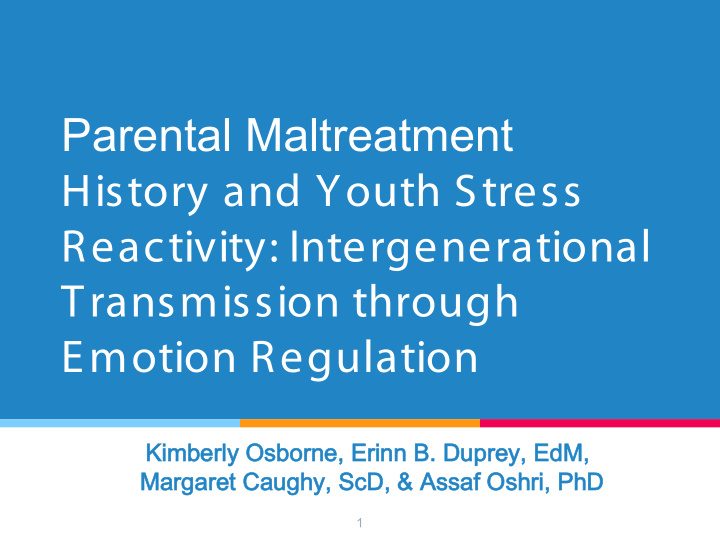



Parental Maltreatment History and Youth Stress Reactivity: Intergenerational Transmission through Emotion Regulation Kimberly Osborne, Erinn B. Duprey, EdM, Kimberly Osborne, Erinn B. Duprey, EdM, Margaret Caughy, ScD, & Assaf Oshri, PhD Margaret Caughy, ScD, & Assaf Oshri, PhD 1
Childhood Maltreatment Childhood Maltreatment ▷ Linked to socioemotional impairments in adulthood (Anda et al., 2006; Felitti et al., 1998) ▷ Disrupts developing regulatory systems Intergenerational Transmission Intergenerational Transmission ▷ The next generation are more likely to display poor emotional development (Collishaw, et al.,, 2007; Miranda, de la Osa, Granero, & Ezpeleta, 2013) 2
Emotion Regulation (ER) Emotion Regulation (ER) ▷ The ability to accurately identify, understand, and modulate emotional experiences as appropriate in a given situation (Kaufman et al., 2016) Issues with ER in childhood Issues with ER in childhood ▷ Linked to self-harm behaviors, anxiety disorders, substance abuse, depression, and conduct problems (Beauchaine, Gatzke-Kopp, & Mead, 2007; Kaufman et al., 2016). 3
Autonomic Nervous Autonomic Nervous Heart Rate Variability (HRV) Heart Rate Variability (HRV) System System Sympathetic Sympathetic Parasympathetic Parasympathetic ▷ HRV is the normal Nervous System Nervous System Nervous System Nervous System variability in heart (fight-or-flight) (rest and digest) rate that occurs due to respiration. ▷ Decreases in HRV when exposed to stress or challenge indicate more parasympathetic activity ○ Prior research supports sex differences in the parasympathetic control of HRV (Koenig et al., 2017) 4
Mechanism for the Intergenerational Transmission of socioemotional impairments Child’s Child’s Parental Parental Parent’s Parent’s Physiological Physiological ? Maltreatment Maltreatment Emotion Emotion Emotion Emotion History History Regulation Regulation Regulation Regulation 5
Hypothesis 1: Hypothesis 1: Parents’ poor ER will act as an indirect mechanism linking childhood maltreatment history to children’s physiological dysregulation of emotion. Hypothesis 2: Hypothesis 2: Pre-adolescent girls will demonstrate more physiological dysregulation than their male counterparts and be more affected by parental ER in the home. 6
Characteristics of the Sample N = 101 parent-child dyads 75.2% 8.9% All below 200% of the African Latino federal poverty line 5% American Child Age: Native 9- 12 years old American Child Sex: or Other 52.5% Female Primary Caregiver Sex: 95% female Case with Child Services: 8.8% open 10.9% 16.5% closed Caucasian 7
Construct Measure Parent’s Experiences Childhood Trauma = of Childhood Questionnaire (CTQ; Maltreatment Bernstein & Fink, 1997) = The Difficulties in Parent’s Emotion Emotion Regulation Regulation Scale Short Form (DERS -SF; Kaufman et al., 2016) HRV-reactivity. = Emotion Regulation Higher scores = less of the Child regulation (Laborde, Mosley, & Thayer, 2017) 8
Model 1 Model 1 Figure 1 . Structural equation model. Model fit was good: CFI = .974, TLI = .951, RMSEA = .054, SRMR = .068. * p < .05, ** p < .01, *** p < .001 9
Model 2 Model 2 1 = Male, 2 = Female Figure 2. Structural equation model. Model fit was good : CFI = 1.000, TLI = 1.000, RMSEA < .001, SRMR < .001 a p < .10, * p < .05, ** p < .01, *** p < .001 10
Model 3 Model 3 Hypothesis 1 Figure 3. Structural equation model. Model fit was good : CFI = .977, TLI = .965, RMSEA = .044, SRMR = .053. Note. Gender is coded as 1 = male and 2 = female. a p < .10, * p < .05, ** p < .01, *** p < .001 11
Figure 4. The association between parent’s emotion regulation (DERS Goals) and child’s HRV reactivity, moderated by gender. Higher HRV-Reactivity scores indicate less regulation. 12
Summary ▷ The intergenerational transmission of poor emotion regulation is a potential risk for children ▷ Girls age 9 – 12 appear to be more physiologically vulnerable ▷ Boys appear to be more vulnerable to their parent’s ER difficulties. ▷ Perhaps reduced ER socialization in the home is more detrimental to boys, while girls receive this socialization more often from other adults in their lives and the broader society. Social Determinants of 13 Child Development
Implications ▷ Behavioral interventions for children should include components on both socio-emotional intelligence and methods to regulate physiological reactivity ▷ Policies that address gross inequalities in wealth can ameliorate additional stressors influencing emotion regulation for parents and the development of emotion regulation in children Social Determinants of Child Development 14
Thank you! Questions? Questions? You can find me at: Kimberly.Osborne@uga.edu www.sdcdlab.org www.fcs.uga.edu/hdfs/research-youth- development-institute 15
Discussion Questions 1. How do you personally regulate your emotions? Do you sense them on a physiological level? 2. What factors do you perceive as important in changing experiences for families in similar positions? If we were to design an intervention, in what ways could we utilize the results found in this study? 16
Credits Special thanks to all the people who made and released these awesome resources for free: ▷ Presentation template by SlidesCarnival ▷ Photographs by Unsplash 17
Recommend
More recommend